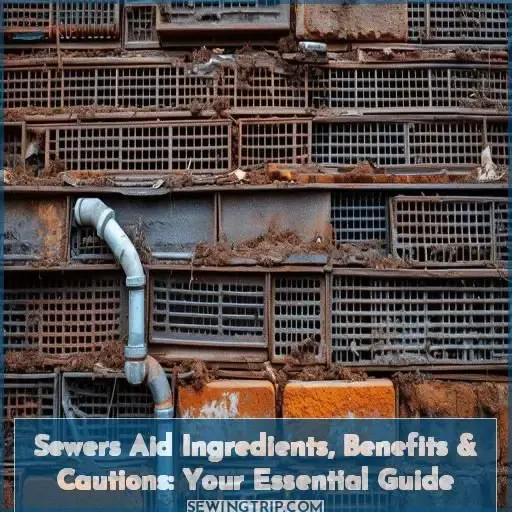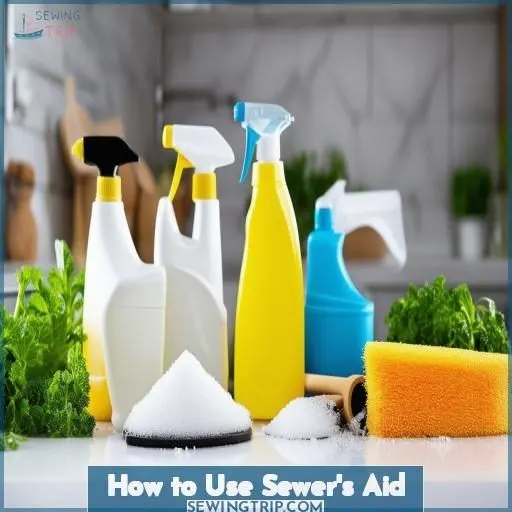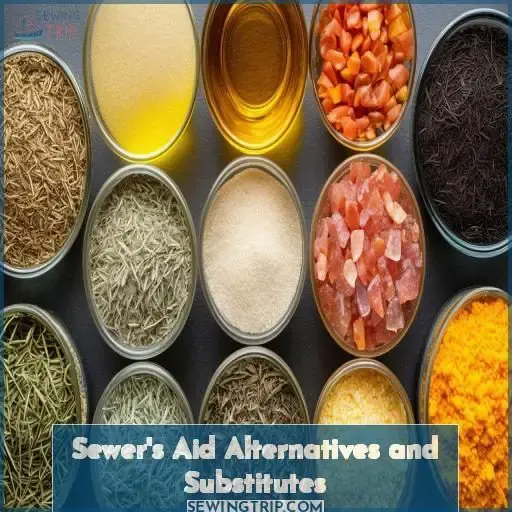This site is supported by our readers. We may earn a commission, at no cost to you, if you purchase through links.

It’s easy to use: lubricate thread spools, touch the needle tip, and apply a bit to the bobbin. Just don’t soak the thread or apply it directly on fabric.
Remember to store it cool and dry.
While the exact ingredients aren’t disclosed, it’s mainly silicone-based, much like mineral oil.
Keep it away from kids and pets for safety.
It’s essential for smooth stitching, and if you want more tips and tricks, there’s even more detailed guidance ahead!
Table Of Contents
Key Takeaways
- Lubricate like a sewing superhero: Sewer’s Aid is your secret weapon to tame sticky threads and friction, making sewing a breeze.
- Use it like a wise old owl: Apply it sparingly to avoid a buildup that could make your sewing machine act like a grumpy cat.
- Keep it safe: Store it like a precious jewel, away from curious little hands and furry friends.
- Alternatives await: If Sewer’s Aid isn’t your cup of tea, try Thread Heaven or beeswax for a natural touch.
What is Sewer’s Aid?
Sewer’s Aid is a lubricant specifically formulated to help reduce thread stickiness and friction during sewing projects. Ideal for use on sewing machine needles, thread, and fabric, it enhances the sewing experience by making threads glide smoothly.
Though lacking explicit ingredient disclosure, it’s advised to treat it as a silicone substitute. Factory concerns include potential buildup on tension disks, especially in computerized machines, necessitating careful application.
It’s a versatile aid for simplifying sewing machine operations and preventing thread issues.
Sewer’s Aid Ingredients
The exact ingredients in Sewer’s Aid aren’t disclosed, but it’s treated as a silicone-based product (Source). If you’re considering a substitute, make sure it’s silicone-based. Remember:
- Factory-trained advice: Avoid use in computerized machines due to tension disk buildup.
- Risks: Minimal, if used sparingly, especially concerning computerized machines.
- Advantage: Efficiently lubricates thread, mitigating issues in sewing.
Elevate your sewing game with the right products, mindful of machine safety!
How to Use Sewer’s Aid
Moving from the ingredients, let’s explore how to use Sewer’s Aid effectively.
- Run the tip down the spool to lubricate different thread types, reducing stickiness.
- Touch the needle tip to prevent thread fraying during embroidery.
- Apply a drop when winding the bobbin to guarantee smooth operation and troubleshoot thread tension.
This silicone-based solution, akin to mineral oil, is key for enhancing machine embroidery. Remember, moderation is critical. Overusing can cause buildup and other issues.
Benefits of Using Sewer’s Aid
Using Sewer’s Aid enhances sewing by lubricating the thread, reducing friction, and preventing breakage, which leads to a smoother sewing experience and less lint buildup. It also helps metallic and monofilament threads glide smoothly without twisting, making it indispensable for intricate projects .
Lubricates Thread for Easier, Smoother Sewing
Sewer’s Aid lubricates thread effectively, leading to smoother sewing, reducing thread tension and breakage. Use a thin stripe on spools, especially metallic threads, and apply a drop to the needle for proficient performance. Avoid overuse, particularly in computerized machines, to prevent lint buildup and guarantee long-term reliability.
| Application | Benefit |
|---|---|
| Thread Spool | Reduces tension |
| Metallic Thread | Prevents fraying |
| Needle Tip | Enhances glide |
Cuts Down on Lint Buildup
Besides making your thread run smoother, Sewer’s Aid is a lint mitigation tool. It greatly reduces lint buildup, which can cause tension issues and machine wear. By applying it sparingly, you cut down on lint accumulation, ensuring cleaner, more efficient sewing operations. This helps maintain Bernina’s thread lubricator guide recommendations.
Makes Thread Glide Nicer Through Fabric
Reducing lint is only part of the challenge. You also want your thread gliding smoothly through fabric. Using Sewer’s Aid enhances fabric smoothness with superior lubrication techniques, ensuring a desirable thread flow. This efficiency allows for more seamless stitches, enhancing your sewing experience considerably, especially with challenging materials.
Prevents Metallic or Monofilament Threads From Twisting
Additionally, utilizing Sewer’s Aid can prevent metallic or monofilament threads from twisting by lubricating them, reducing tension problems. A quick application on the side of the thread spool or needle guarantees smoother sewing. Alternative lubricants like beeswax or silicone-based products might help but confirm their compatibility for specific fabric types and machines .
Cautions When Using Sewer’s Aid
When using Sewer’s Aid, apply it sparingly and avoid soaking the thread as excessive use can lead to buildup that disrupts machine performance. Always apply to the thread, not directly to the fabric, and keep it out of reach of children, storing it in a cool, dry place .
Use Sparingly, Do Not Soak Thread in Sewer’s Aid
Use Sewer’s Aid sparingly; don’t soak threads. Overuse can lead to build-up on tension disks.
- Apply in small amounts to thread, needle, or bobbin
- Avoid direct application to computerized machines
- Store properly to guarantee child and pet safety, preventing accidental ingestion or misuse
Apply to Thread Only, Not Directly to Fabric
To avert thread buildup and fabric damage, apply Sewer’s Aid solely to your thread, not directly onto the fabric. This guarantees your sewing machine’s safety and maintains fabric integrity. For alternative uses and DIY solutions, consider its application on the needle and bobbin, providing smoother sewing without fabric residue.
Keep Away From Children and Pets
When using Sewer’s Aid, make certain it’s stored safely, away from curious hands and paws. Children’s safety and pet safety should be prioritized. The product’s ingredient safety hasn’t been fully disclosed, so don’t risk exposure. Choose a secure storage location to prevent accidental contact (Source).
Store in a Cool, Dry Place
To guarantee Sewer’s Aid’s continued effectiveness, consistently store it in a cool, dry location. Appropriate sewer’s aid storage prevents moisture and temperature-related problems. Avoid exposing it to extreme temperatures, keeping it out of places like humid basements or attics. Consider airtight containers for ideal moisture protection and longevity.
Sewer’s Aid Alternatives and Substitutes
Consider using Thread Heaven or beeswax as effective alternatives to Sewer’s Aid for cotton hand-quilting threads. Both can reduce stickiness and friction, ensuring smoother sewing .
Thread Heaven
When using Sewer’s Aid, it’s crucial to examine alternatives. Thread Heaven, previously renowned for its thread-conditioning properties, is a top substitute. It’s designed to reduce friction, prevent tangling, and enhance the smoothness of sewing processes.
Particularly effective with monofilament threads and intricate hand-sewing tasks, it helps your sewing needle glide effortlessly through sticky materials without buildup. Applied similar to Sewer’s Aid, you’ll find it reliable for reducing lint, frays, and breakage.
Although it’s discontinued, many recommend a beeswax substitute for a similar effect . Thread Heaven remains an excellent option to replicate Sewer’s Aid benefits.
Beeswax for Cotton Handquilting Threads
Beeswax is an excellent substitute for Sewer’s Aid, especially when working with cotton handquilting threads. Here’s why you should consider it:
- Thread Lubrication: Beeswax helps threads glide smoothly, reducing friction, and making it easier to sew .
- Lint Control: It minimizes lint buildup on the thread and fabric, maintaining smooth stitching.
- Thread Strength: Beeswax strengthens cotton threads, preventing them from fraying or breaking during handquilting.
- Ease of Use: Simply run your thread through beeswax before quilting; it’s straightforward and effective.
Incorporate beeswax into your quilting supplies for superb thread care.
Where to Find Sewer’s Aid
You can find Sewer’s Aid in the notions section of fabric stores. This silicone-based product effectively reduces thread friction and breakage, making your sewing projects smoother.
Whether you’re using metallic threads or dealing with sticky materials, having Sewer’s Aid handy can make all the difference. Popular among sewers, it’s a staple for ensuring seamless stitches and maintaining thread integrity.
Frequently Asked Questions (FAQs)
How to use sewers aid for sewing machine?
Run the tip of Sewer’s Aid down the thread spool, touch the needle to add lubrication, apply a drop to the bobbin thread, and use sparingly to prevent buildup in computerized machines to maintain best performance (Source).
What is all-purpose sewers aid?
Sewer’s Aid, akin to a magic wand for sewing, is a silicone-based lubricant. You apply it sparingly to thread, needles, or fabric to reduce friction, minimize thread breakage, and enhance sewing efficiency .
Can Sewers Aid be used on embroidery hoops?
You can use Sewer’s Aid on embroidery hoops to reduce friction and ease thread movement. Apply it sparingly to the needle, but avoid direct contact with fabric to maintain good performance and prevent residue buildup.
Is Sewers Aid safe for vintage sewing machines?
Yes, you can use Sewer’s Aid on vintage sewing machines in small quantities. Apply sparingly to the needle or thread spool to minimize friction and prevent buildup on tension disks, but avoid using it on computerized models .
Does Sewers Aid affect sewing machine warranties?
Using Sewer’s Aid on your sewing machine may void the warranty, as its buildup can cause mechanical issues, particularly in computerized models. Always verify with your machine’s manufacturer or warranty provider to confirm compliance .
Can Sewers Aid be used with polyester threads?
Yes, Sewer’s Aid can be used with polyester threads. It helps lubricate the thread, reducing friction and preventing breakage, ensuring smoother sewing .
Are there any eco-friendly alternatives to Sewers Aid?
You’ve discovered a treasure trove! Eco-friendly substitutes for Sewer’s Aid include beeswax and Thread Heaven. These options simplify your sewing, reduce lint, and offer a sustainable alternative to traditional silicone-based products.
Conclusion
All good things come to those who sew wisely. With Sewer’s Aid, you can enhance your sewing efficiency, ensuring smoother stitches and less lint buildup. Remember, it’s silicone-based, offering benefits like reduced friction and preventing twisted threads.
Just use it sparingly, keep it away from kids and pets, and store it properly.
When considering substitutes, options like Thread Heaven or beeswax for handquilting threads are viable. Use these tips to maximize your sewing experience with Sewer’s Aid .













